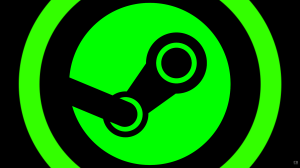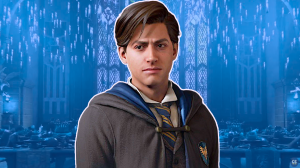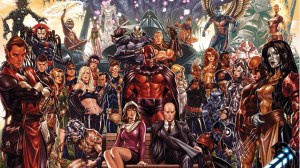
Two recent Millarworld mini-series, “Empress” and “Reborn,” are flip sides of the same coin.
Videos by ComicBook.com
“Empress” is a sci-fi/fantasy space opera that functions as an ode to “Star Wars.” The queen takes her kids and runs away from the dictatorial husband who rules with an iron fist. He doesn’t respond well. It’s Mark Millar writing a Saturday matinee serial. There’s space ship races, hand-to-hand combat with aliens, laser guns aplenty, and even a magical flying transporter device. It’s all about the momentum, the set pieces, and the experience.
“Reborn” is a fantasy piece that centers on one character and her exploration of life post-death and all that entails. She’s reunited with loved ones and comes up against some surprising blasts from the past. It touches on relationships with people, pets, and religion. While it still depends on a fair level of kicks and punches to tell the story, there’s a thoughtfulness and a philosophical bent to it.

I think “Reborn” is a better book just because it’s more character-centered. That is, we get to know the main character in a deeper way. She’s multi-dimensional, as are some of the people around her. Millar twists those relationships in shocking and occasionally crazy ways, but at the core it’s still about the characters and their arcs.
Granted, the villains lean more towards the one dimensional side, but at least they have good reasons for being angry and murderous. In “Empress,” the bad guy is bad because he’s bad.

“Empress” loses a lot of that character work in service to the format. It feels like a collection of action sequences ending on cliffhangers to draw you forward to the next ludicrous situation. It’s a writing exercise to plant enough pieces along the way that the final issue will make sense and have enough callbacks to make the book look more purposeful in retrospect. It’s smart writing sleight of hand in that way, but ultimately less satisfying.
If an idea comes to mind, Millar will throw it in as a set piece between two other set pieces, each of which might only last for a couple of panels.
“Reborn” is an exploration of its world, as well, but it always feels like a logical progression of events. One thing causes another to happen, and often it’s due to a decision the character is making. It’s less straight forward and feels more like the character is in control and, in fact, is guiding the story.
“Empress” has a series of events that, for the most part, the lead character is dragged through. She has few decisions to make once the story kicks off. Another characters lists the places that’ll take her, and then takes her there.
It feels like Millar is telling you all the levels of the video game you’re about to play on the way to fighting the Big Bad.
By the end of the seven issue series, I don’t feel a terribly deep connection to any of the main characters I just spend more than 200 pages reading about.
Artistic Showcases
Setting aside the story (which is always a dangerous thing to do with a comic book), they’re both perfect set-ups to serve as showcases for their artists. Every world and character needs to be created from scratch, and both artists thrive in the environment.
“Empress” is drawn by Stuart Immonen (with inks by Mark von Grawbadger), who hasn’t drawn a bad comic book in more decades than you’ve likely been reading comics. Even when the script isn’t top notch, his art is beautiful.
But when the two mesh, you get the genius of “Nextwave: Agents of H.A.T.E.” or “Shockrockets” or even his all-too-brief run on “Star Wars.” It’s pure magic. Immonen’s design sense is immediately obvious, but he also has a firm handle on character drawing. Emotions are clear and the body language is unique by its own silhouette.
With a book like “Empress,” we also see him draw planets of every type, though most notably ones that feature skyscraper-laden cities. Beyond that, though, he designs ships of all sizes and laser guns and robots and aliens on every page. This is the kind of book that should take so long to draw that it can’t ever be profitable. Thankfully, Immonen is able to pull it off, and the results in this book speak for themselves.

Look, he can even draw cool explosions!
It’s a stunning book. His art is well complemented by Ive Svorcina, who knows how to highlight the art without hiding it. Svorcina uses just the right amount of detail in his coloring to make the storytelling clear while adding something of interesting to every page, whether it be reflections on armor, glowing lights on the side of ships, highlights on cheekbones, and so much more.
Most of all, he keeps things bright enough that no line of art gets hidden. To that end, there’s also a surprising lack of color holds in the series. That’s the first crutch way too many colorists use today to force depth. It usually hides the art and makes things look incomplete.
Greg Capullo is the co-creator on “Reborn,” and uses it to show a different side to his art. I don’t think anyone would have expected Capullo to be drawing a fantasy series. Yes, the bits with armor and massive chaotic fighting might be expected, but the lush green landscapes and more imaginative parts of the other world the series is set in will likely surprise many. (Capullo would draw the heck out of a book about winged fairies, for example.)

By the end, it gets into the sword fights and the pools of blood and some of the fantastical element that you might expect from the artist of “Spawn” and “Batman,” but there’s plenty along the way that’s surprising and wonderful.
And then there are the large two page spreads that are show-stoppers, intense in detail and depth. Capullo draws entire armies and their surrounding environments on pages that you know gave his inker and colorist headaches.
As with Svorcina over Immonen, FCO Plascencia’s colors over Capullo’s art let the art be the star. They’re bright and colorful, letting the ink lines show the modeling and the contours. There’s remarkably little work on these pages as far as shadows go. I only noticed that no in writing this review. Capullo’s art — particularly with the ink lines from Jonathan Glapion — serves all the function that art is meant to in a comic. It provides all the clues the reader needs for textures and shadows and dimension.
Both Immonen and Capullo produce impressive work in these two mini-series, in ways that their usual superhero-drawing day jobs wouldn’t normally give them. I’d love to see them do more stuff like this.
One Final Comparison
I much prefer Nate Piekos’ lettering on “Reborn” to Peter Doherty on “Empress.” The latter just looks uncomfortable. There’s not enough space inside the balloons to let the letters breathe, and those long skinny bent tails don’t do anything for me, either.

Doherty’s balloons often look like rounded rectangles. I don’t like those wide flat balloons. If you’re used to the diamond-shaped layout of letters in every other word balloon in North America, this might be a bother.
Sure, this is all subjective. All the balloon tails are pointing to the right mouths, the font is good, and everything is spelled right. Stylistically, Doherty’s lettering just doesn’t jive with my own tastes. The only fault of craft I can find, again, are some of those too-small balloons where the words don’t have enough room to breathe.
Go Forth and Read
I enjoyed both books, but for slightly different reasons.
“Empress” is a runaway train of action and adventure, planet-hopping and running and jumping all over the universe. This is at the expense of characterization.
“Reborn” has beautiful fantastic visuals with a deeper main character that relies a little bit more on promoting a mystery with a more active character participating in the plot. That’s why I give it the upper hand.
PipelineComics.com|| Twitter || Instagram || E-mail









